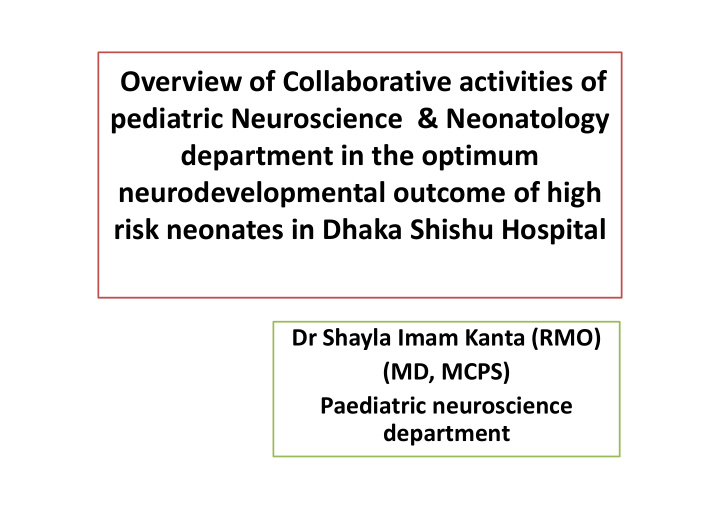



Overview of Collaborative activities of pediatric Neuroscience & Neonatology department in the optimum neurodevelopmental outcome of high risk neonates in Dhaka Shishu Hospital Dr Shayla Imam Kanta (RMO) (MD, MCPS) Paediatric neuroscience department
A majority of neonates present with histories of brain insult in the of brain insult in the antenatal, natal and post natal periods
� Identification, appropriate assessment and intervention are crucial for the best neurodevelopmental outcomes. � In DSH the Paediatric Neuroscience Department (PND) is working in this regard in the neonatal ward as well as in its Child Development Center (CDC) with a multi- disciplinary team of professionals
Objectives � To describe the activities of PND in the � To describe the activities of PND in the management of high risk neonates.
Method � July 2017- December 2017 � � every neonate admitted in the every neonate admitted in the neonatal ward � Rapid Neurodevelopmental Assessment (RNDA) tool by a Developmental Therapist
� RNDA is a validated tool for neurodevelopmental assessment applied for ages between 0-16 Years . � RNDA is a set of unique tools which have been developed developed over over several several years years by by a a team team of of committed researchers so that single professionals are able to conduct the assessment on children’s universal functional abilities Khan NZ, Muslima H, Begum D, et al. Validation of rapid neurodevelopmental assessment instrument for under-two-year- old children in Bangladesh. Pediatrics 2010;125:e755–62
NRNDA applied on neonates during discharge No or mild Moderate -Severe impairment impairment General developmental NRNDA Follow up assessment By neurologist 1 , 3,6,9,12,18,24 months Follow up Follow up
Assessment of Gross motor
Assessment of primitive reflexes
Visual assessment Hearing assessment
Intervention � Treatment of neurological complications (like seizures,other treatable complications ). � vitamin or micronutrients � vitamin or micronutrients supplimentation � Early intervention � Feeding & nutritional advise
Advise for the parents � Please bring your child in child development centre on the scheduled date � Please bring the yellow card � Please bring the yellow card � Notice the normal development of your child and please try to note down � Please try to follow the advise by CDC.
Result
Figure : Term : Preterm 160 140 120 100 80 60 40 20 0 term preterm
Figure: Male : female ratio female 45% male male 55%
Table : impairment grading in different Table : impairment grading in different domains(n=248) domains(n=248) No (%) Mild (%) Moderate (%) Severe (%) Colum total p value Gross motor 50 31 9 10 .000 ⃰ Fine motor 57 32 5 6 .000 ⃰ Vision Vision 63 63 24 24 9 9 4 4 .000 ⃰ .000 ⃰ Hearing 86 7 5 2 .038 ⃰ Primitive ref 43 39 9 9 .000 ⃰ Cognition 91 4 2 3 .217 P value < .05 is significant
Conclusion � Every neonate who is at high risk needs assessment, evaluation, intervention and and follow-ups, follow-ups, which which can can prevent prevent future impairments and disabilities .
This is possible by establishing a sound communication -between � Different sub-specialities with � Different sub-specialities with � neurology and child development services in tertiary care hospitals.
ACKNOWLEDGE: • Prof Mahbubul Haque • Dr Maksudur Rahman • Developmental therapist • Dr Moshiul azam • Dr Moshiul azam • Dr Selina Husna Banu
Thank you
Recommend
More recommend